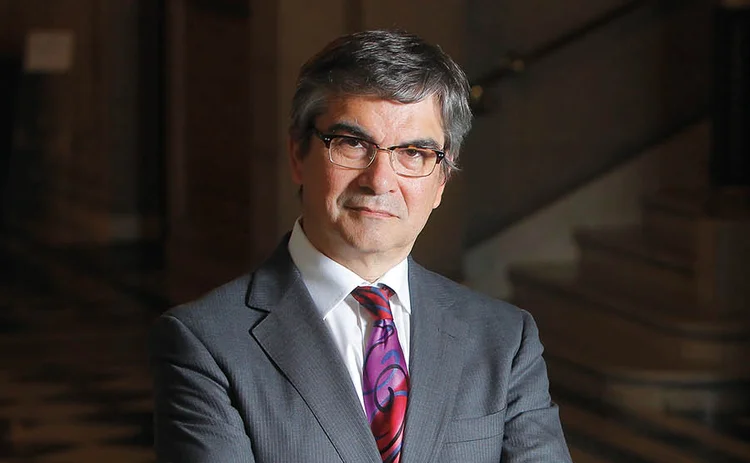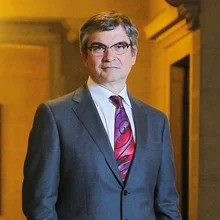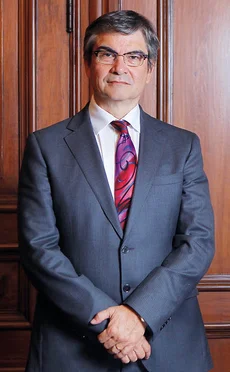
Governor of the year: Mario Marcel
Chile’s governor has expertly navigated a third currency crisis while bolstering the BCCh’s capabilities

When Mario Marcel was named governor of the Central Bank of Chile (BCCh) in October 2016, he took over the leadership of an institution that had secured a reputation as one of the most independent and well-run central banks in Latin America. Marcel took steps to further improve the institution. He changed its internal management structure, reducing the number of monetary policy meetings from 12 to eight. The BCCh also improved the quality of its communications in both English and Spanish. But the BCCh’s reputation, as well as Marcel’s own, would be put to a severe test from 2019.
In October that year, Chileans started holding increasingly large street protests. These rallies initially denounced rises in public transport prices. But they soon morphed into major demonstrations calling for changes to the country’s economic structure to address inequality and the rising cost of basic goods. The political unrest reached the highest levels Chile had faced since the military coup of 1973.
As the currency of a relatively small, open economy, the Chilean peso came under severe pressure on foreign exchange markets as investors became nervous. The peso hit a low of around 800 to the US dollar in November 2019. The Chilean central bank had typically allowed the foreign exchange rate to fluctuate as a stabilising mechanism to address economic stresses. But, in an effort to restore confidence in the currency, the BCCh carried out large-scale FX interventions in late 2019. It spent approximately $20 billion of its foreign exchange reserves, at a time when its portfolio was around $40 billion. Ultimately, the BCCh’s communications and interventions convinced market participants that the selloff was overdone.
Just as the markets stabilised in early 2020, however, the Covid-19 pandemic struck.
New tools against Covid-19
By March 2020, Chile – along with other economies around the world – was experiencing a rapid economic slowdown due to the coronavirus. The BCCh responded by cutting policy rates to a record low of 0.5%. It also implemented asset purchase programmes for the first time, expanded its collateral framework and approved funding-for-lending facilities.

In a bid to tame high volatility in debt securities markets, the central bank unveiled two asset purchase programmes totalling $16 billion. The BCCh approved a $8 billion envelope to purchase banks’ bonds in March 2020. In June, it launched its special assets purchase programme – another $8 billion envelope to buy banks’ bonds as well as buybacks of central bank securities.
The expanded collateral framework allowed banks to post corporate bonds and loans as collateral to access BCCh operations. To mitigate banks’ exposure to these new sources of risk, the central bank imposed a haircut and limits on the stock of collateral accepted. Furthermore, it temporarily allowed lenders to meet FX reserve requirements using assets denominated in euro, yen and Chilean peso in addition to the US dollar.
The central bank also unveiled three funding-for-lending facilities with an overall volume of $40 billion. The first facility was introduced in March 2020. It aimed to provide financing to commercial banks at the monetary policy rate, on the condition that they boosted lending for consumers as well as for small and medium-sized enterprises. This first tool offered banks up to $24 billion. The second line, worth $16 billion, was introduced in June 2020. It was allocated to banks depending on the growth of their portfolios. With the $10 billion in unused funds from these two facilities, the central bank ultimately presented a third line in January 2021. This was used to refinance loans to make sure firms did not abruptly lose access to credit during the recovery.
Reputational risk
Despite its solid macroeconomic record, Chile’s reputation for sound economic management was challenged in 2020. The country’s congress permitted citizens to make transfers out of their pension funds in a bid to bolster assets during Covid-19. Observers criticised the scheme for creating long-term pension-funding risks, and distortions in capital markets as pension funds were forced to sell assets to meet drawdowns. Marcel repeatedly demonstrated his and the central bank’s independence by publicly warning that these transfers might harm financial stability.
The combined effects of the pandemic and political instability caused the peso to weaken significantly once more. It reached a low of 865 to the US dollar in April 2020. But behind the scenes, efforts were already under way to restore confidence.
The BCCh played a key role in negotiating a two-year, flexible credit line (FCL) deal between Chile and the International Monetary Fund, which was finalised in May. FCL deals are large, non-conditional credit packages. Chile’s was worth around $24 billion, or 17.443 billion in Special Drawing Rights, which is 10 times greater than the country’s quota. These resources have not been deployed, but serve as insurance in the context of high uncertainty created by the pandemic. The IMF only agrees to FCLs when it is convinced of the soundness of the recipient’s institutions, and that included the BCCh. The IMF has also subjected Chile to regular reviews under the FCL programme, praising the quality of its economic management.

In July 2020, the central bank implemented two measures to smooth the impact of pension withdrawals. It offered up to $10 billion in bank bond purchases with a sale back to banks within one to three months. The central bank also purchased banks’ term deposits of up to $8 billion.
A month later, the BCCh expanded its currency swap line with the People’s Bank of China to 50 billion yuan ($7.9 billion), from 22 billion yuan previously. This gave the central bank yet more potential firepower to intervene during a crisis.
When lawmakers approved a new withdrawal from the pension system in December 2020, the central bank reactivated both instruments it had used to smooth the impact. It funded this with the unused funds approved in July.
These central bank policies helped the peso to recover to 710 against the US dollar by December 2020.
During 2021, the BCCh implemented a number of important governance improvements. It adopted a new transparency policy in June, based on the IMF’s code for good practice. The central bank has created a new section on its website providing additional information on the way it operates. This includes documents on the legal framework underpinning its independence, instruments and policy targets. Another section contains information on its governance structure and on the responsibilities attached to each department.
For the first time, the central bank published the remuneration of all its staff members by category and the third-party contracts it has. It is also starting to provide the result of external audits of its budget, and to provide ways for citizens to interact with it.
Other efforts included a campaign to encourage Chileans to stop hoarding coins and get them back into circulation.
Inflation’s return
As Chile’s post-Covid recovery began in earnest in 2021, the BCCh faced a similar problem to that of many of its peers – rising inflation. So far, its reaction appears to have been prudent and timely. It began raising rates by 25 basis points in July, and hiked them by another 475bp at its four subsequent policy meetings. While the BCCh has moved faster than most of its peers, inflation still rose quickly to hit 7.7% year on year by January. It remains to be seen if tighter policy will have the desired effect of bringing inflation down to 3% over a two-year period.
Addressing inflation was not the only challenge the BCCh faced last year. Emerging-market currencies faced major pressure. Observers also had serious worries over the outcome of Chile’s presidential election, including whether both sides would accept the result. These factors caused the peso to plunge for a third time in two years.

Amidst this, Marcel, who was reappointed governor in October, continued to vigorously oppose calls for another round of transfers from pension holdings. He said in November 2021 that “the repeat of forced asset liquidations” by pension funds was the “principal risk to financial stability”. The BCCh’s prudent measures and its strong record helped maintain confidence. The peso recovered from 871 to the dollar in December to 797 on February 22. One source of pressure on the peso then lifted when the election concluded with a peaceful transfer of power. Marcel resigned his post as governor in January 2022, and agreed to become finance minister under the new administration of president Gabriel Boric. Observers see his appointment as an attempt to reassure Chileans and overseas investors that the new government will follow sound economic policies.
Marcel had also continued to build up buffers to better protect Chile against future pressure on the peso. The BCCh built up its foreign exchange reserve portfolio to $50 billion. This was about one-fifth larger than it was before the onset of the first currency crisis in 2019. Moreover, under Marcel’s leadership, the BCCh continued to develop safety nets. In February 2022, it joined the Latin American Reserve Fund, or Flar, a regional network of central banks that aims to foster FX stability by offering funding to members at times of stress. Flar’s executive president, José Darío Uribe, said Chile’s membership would strengthen the region’s financial safety net and show other countries the importance of joining the network.
Because of social unrest, Chile is now examining changes to its constitution to offer a more balanced sharing of economic growth. Observers say, however, that they do not expect this to result in reducing the central bank’s independence – a view echoed by Marcel himself. If this expectation turns out to be true, it would indicate that the BCCh retained public trust at a critical time when Chileans were questioning how their economy was governed.
While no central bank governor has had a routine task since the outbreak of Covid-19, Marcel has led the BCCh through a series of crises that started before the pandemic. The central bank, under his leadership, faced a major challenge to financial stability linked to political instability, and moved early to tighten monetary policy while improving buffers and governance. Overall, Marcel’s efforts have protected the Chilean economy from the worst consequences of the crises. He has also sought to strengthen the BCCh’s capacity to deal with future problems.
The Central Banking Awards were written by Christopher Jeffery, Daniel Hinge, Dan Hardie, Victor Mendez-Barreira, Ben Margulies and Riley Steward
Only users who have a paid subscription or are part of a corporate subscription are able to print or copy content.
To access these options, along with all other subscription benefits, please contact info@centralbanking.com or view our subscription options here: http://subscriptions.centralbanking.com/subscribe
You are currently unable to print this content. Please contact info@centralbanking.com to find out more.
You are currently unable to copy this content. Please contact info@centralbanking.com to find out more.
Copyright Infopro Digital Limited. All rights reserved.
As outlined in our terms and conditions, https://www.infopro-digital.com/terms-and-conditions/subscriptions/ (point 2.4), printing is limited to a single copy.
If you would like to purchase additional rights please email info@centralbanking.com
Copyright Infopro Digital Limited. All rights reserved.
You may share this content using our article tools. As outlined in our terms and conditions, https://www.infopro-digital.com/terms-and-conditions/subscriptions/ (clause 2.4), an Authorised User may only make one copy of the materials for their own personal use. You must also comply with the restrictions in clause 2.5.
If you would like to purchase additional rights please email info@centralbanking.com




